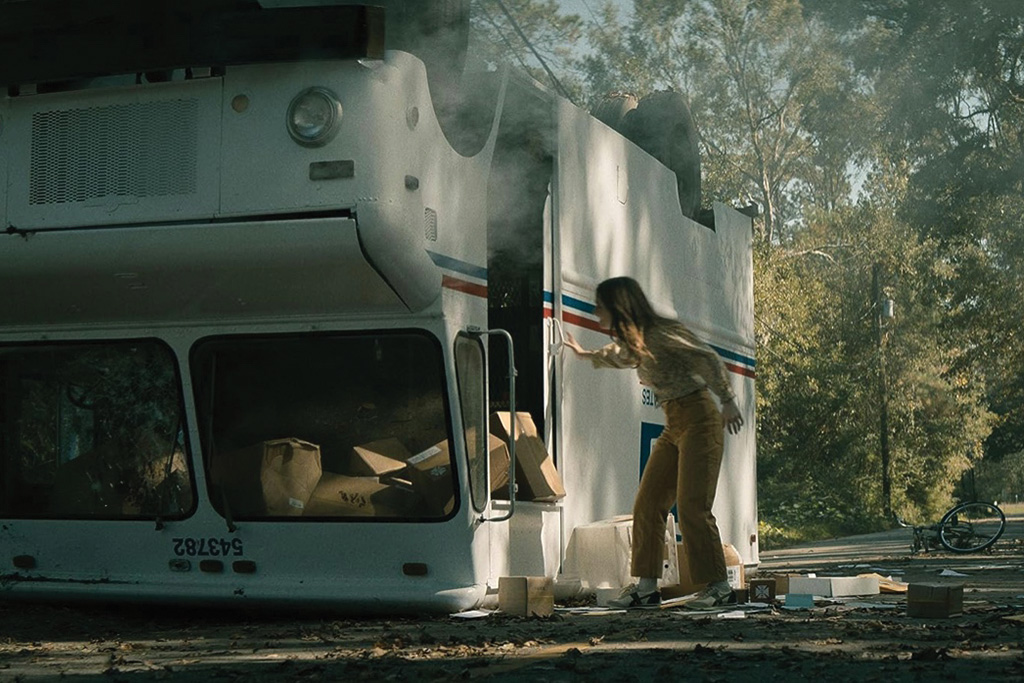 Taylor Swift in Taylor Swift: The Eras Tour ( )
Taylor Swift in Taylor Swift: The Eras Tour ( )While there are several horror movies in theaters this weekend, pop entertainer Taylor Swift and her faithful followers might be the the scariest entities you’ll see haunting multiplexes.
The debut of her concert film “Taylor Swift: The Eras Tour” certainly frightened off all the new competition in theaters.
No other major releases are opening today for fear of getting swallowed up by Swifties, who have already bought more than $100 million-worth of advance tickets for the concert film that will be the biggest hit in theaters since “Barbie” and “Oppenheimer” opened on the same weekend in July.
The power of Swifties even compelled Universal to move “The Exorcist: Believer” off its preferred opening day of Friday the 13th to last Friday.
The film led the box office last weekend with a softer-than-hoped $27 million take, after Universal spewed up $400 million for the rights to the mother of possession franchises. Like all other comers, the Swift concert film is estimated to crush the demonic sequel this weekend, but Universal is hoping for a rebound during the last two weekends of October, leading up to Halloween.
With Warner Bros.’s “Dune: Part Two” moving from its planned opening this month to next March because the Screen Actors Guild strike would keep the film’s stars from promoting the movie, the autumn box office could use some juice. Swift’s film, which bypassed major distributors to negotiate a deal with AMC Theaters, should provide it.
AMC is not limiting the film to just its theaters. If there is a multiplex near you, the Swift movie is almost certainly showing there this weekend. The company is ruffling feathers among production companies for acting as a distributor of sorts itself, but with the film exhibition industry still struggling after the Covid-19 pandemic, AMC is just trying to stay afloat.
Industry insiders don’t expect the concert film to have great legs, but then again, they might be underestimating Swift and her fans. Certainly the producers of Beyonce’s self-titled concert film, which is set to open Dec. 1 through a similar deal with AMC, will be intently watching the box-office returns for the next few weeks.
Director Martin Scorsese’s “Killers of the Flower Moon,” which opens on Oct. 20, is drawing excellent early reviews, but the film that stars Leonard DiCaprio has a three-hour and 26-minute running length that might prove prohibitive to some film fans who want to see a movie but may not want to spend nearly a sixth of a day in a theater seat.
While Swift is seemingly ubiquitous, off the top of my head, I couldn’t name you the title to one of her songs. I’m admittedly greatly out of touch with popular music. In my mind, Guns and Roses and The Black Crowes are still my favorite “new” bands. But I kinda of want to see Swift’s concert movie just to try and understand the hoopla.
I certainly won’t be fighting the crowds this weekend, but maybe in week or two.
Review: No One Will Save You
 Kaitlyn Dever in No One Will Save You (20th Century Studios)
Kaitlyn Dever in No One Will Save You (20th Century Studios)If you are a big horror fan, you’ve probably already experienced the thrill of “No One Will Save You,” which debuted on Hulu on Sept. 22.
I admit I’m late to the party, but I’m glad I arrived. What a fun sci-fi/horror movie that harkens back to the best of the genre from the 1950s and ‘80s with its alien-invasion motif. Despite working in a well-worn genre, the movie was still fresh and thrilling enough to provide me with a kick.
The movie is directed by Brian Duffield, who wrote the scripts for “The Babysitter” (2017), “Love and Monsters” (2020), and “Underwater” (2020). He also directed the dark comedy “Spontaneous” (2020), which I haven’t seen, but now plan to track down after enjoying what he accomplished with “No One Will Save You.”
The plot isn’t exactly original. This ground has been plowed in sci-fi short stories, pulps, comic-books, novels, films and TV shows since the 1930s. It’s parodied most effectively by the long-running “Simpson’s” animated TV series. However, the familiar tropes aren’t played for laughs here, and when the tried and true works, it is still entertaining.
The first quarter of movie is its most entertaining bit when an alien invades the home of the lead character. From there, it’s a bit of a slow burn.
Lead Kaitlynn Dever as Brynn is excellent and her expressive face and physical performance made the movie go. Dever was a co-star on the Tim Allen comedy “Last Man Standing,” for a decade, and was excellent in a reoccurring role on the crime drama “Justified.” The weight of the movie really is on her actions and reactions, and she sells every move she makes.
The movie only has one discernible line of dialogue, although the film’s sound design is very effective. This choice is what makes the movie unique, even though, the “A Quiet Place” franchise (2018) tapped into a similar silence effect first. The lack of dialogue is effective.
The back half of the movie does fall into some well-worn sci-fi tropes, but the irony of the film’s conclusion is a nice exclamation point.
If you know shows like “The Twilight Zone” or “Outer Limits,” you will recognize the similarities, but the set up is so strong that the movie gets by with a mundane follow through.
(Mature) 1 hr. 33 min.
Grade: B
New in Local Theaters – Oct. 13, 2023
- Taylor Swift: The Eras Tour (PG-13) 2 hr. 42 min. (trailer)
(AMC Fiesta Square, Malco Razorback, Malco Springdale, Malco Pinnacle, Malco Towne, Skylight)
Classic Corner – Where Wolf? There Wolf: Favorite Werewolf Movies
The Wolf Man
While the 1941 version of “The Wolf Man” wasn’t the first werewolf movie of the talkie era — that distinction belongs to 1935’s “Werewolf of London” — it is the most influential. Starring Lon Chaney Jr. as the cursed Larry Talbot, “The Wolf Man” established all the familiar lore we associate with the flea-bitten beasts thanks to screenwriter Curt Siodmak.
While Siodmak often told reporters he did intensive research on the condition of lycanthropy when writing the screenplay, it seems he conjured most of it up himself, while lifting the rest from Bram Stoker’s novel “Dracula.”
No matter where Siodmak got the ideas, he put them together in fairly effective fashion in his screenplay. “The Wolf Man” was a B film, but the story and the cast — which included Claude Raines, Ralph Bellamy, Patric Knowles, Bela Lugosi and Maria Ouspenskaya — was strong enough to make the movie memorable.
However, it was the distinctive make-up by Universal Studios chief makeup artist Jack Pierce and Chaney’s forlorn performance that made the film a true classic. Pierce’s makeups for the Wolf Man, Frankenstein, the Mummy and other Universal monsters remain iconic all these years later.
Forty years after its debut, “The Wolf Man” inspired two of the better werewolf films ever made by two fine directors Jon Landis and Joe Dante.
The Howling
Dante’s “The Howling” made it to the theaters first in April of 1981, opening with a chilling scene of a television newswoman Karen White (Dee Wallace) used as bait to capture a serial killer in a porno theater.
Traumatized by the ordeal, White and her husband meet with a therapist, who advises her to go on retreat to “The Colony,” a secluded countryside resort. Little do she and her husband know that werewolves are terrorizing the resort.
Today the werewolf transformations come off as a bit cheesy, but 40 years ago, they were quite thrilling. The film’s climax and ending are quite fun in a horrific type of way.
An American Werewolf in London
In August of 1981, Landis’ “An American Werewolf in London” debuted, and a horror classic was born.
Landis and special effects master Rick Baker, who won the first Academy Award for Outstanding Achievement in Makeup for the film, were big fans of “The Wolf Man.” They not only paid homage to the original, but they also took the concept so much further.
Baker’s transformation scene is brutal and graphic. It set the standard for onscreen metamorphosis prior to the development of computer-generated effects.
Many horror fans would argue Baker’s animatronic and practical transformation effects in the film are still superior to CGI.
The gory film has several genuine scares including the scene in which David (David Naughton) and Jack (Griffin Dunne) are viciously mauled on the foggy moors by the werewolf, and a chilling scene where the werewolf stalks a subway passenger.
David survives the attack and becomes cursed. Jack dies, but returns as a decaying ghoul, haunting David, telling him to take his life before he turns into a wolf and commits murder.
Landis, who also directed “National Lampoon’s Animal House,” “The Blues Brothers,” “Trading Places,” and Michael Jackson’s “Thriller” music video, masterfully blended humor and horror together for an outstanding movie. He effectively used such lunar-themed tunes as Bobby Vinton’s “Blue Moon,” Creedence Clearwater Revival’s “Bad Moon Rising,” and Van Morrison’s “Moondance” to enhance the mood of the film.
All three of these films are fun, but “An American Werewolf in London” is the pride of the pack.

